Role of Transportation Management Centers in Emergency Operations Guidebook
| ||||||||||||||||||||||
| Resources and Services | General Practice | Best Practices |
|---|---|---|
| Assist in incident detection and verification |
|
|
Initiate Traffic Management Strategies on Impacted Facilities Establish and Operate Alternate Routes |
|
|
Protect the Incident Scene and Provide Traffic Control Provide Special Equipment Clearing for Incident Scenes Determine Incident Clearance and Roadway Repair Needs Coordinate Clearance and Repair Resources Repair Transportation Infrastructure |
|
|
| Initiate medical assistance until help arrives |
|
|
| Assist motorists with disabled vehicles |
|
|
| Provide motorist information |
|
|
Source: Traffic Incident Management Resource Guide, FHWA, June 2009, p. 708.
Key: L = Large Incidents only; S = Small Incidents only; No Designation = covers both.
The TMC can use the following checklist to evaluate their current status in regard to participation in traffic and large-scale incidents (check all that apply):
Traffic Incidents
❑ Shares space with emergency operations personnel.
❑ Maintains direct links to law enforcement Computer Aided Dispatch (CAD) systems, and obtain dispatch reports in near real time.
❑ Has access to the location of all DOT resources, including maintenance vehicles, and coordinate with the incident scene commander and other DOT departments to deploy these resources as needed.
❑ Provides information on the location of the incident quickly to the public through multiple communications channels.
❑ Has the ability to automatically locate and dispatch support vehicles where needed at the request of the scene commander.
❑ Has Freeway (safety) service patrols with EMT-trained personnel who can initiate medical response prior to arrival of scene commander and other responders.
❑ Has multiple options for communicating with the public, including relationships with media and private web sites, as well as developing communications through social media.
❑ Provides tow vehicles on call for multiple types of vehicles, including large trucks.
Large-Scale Incidents
❑ Uses a variety of operational systems, including ramp meters and coordination with arterial signal operations personnel to implement preplanned strategies for managing traffic in and around the incident.
❑ Identifies preplanned detours routes that are incorporated into the freeway management system.
❑ Provides automated guidance on traveler information messages, signal/ramp meter timing, and preferred detour routes.
❑ Has traffic control plans for specific types of roadway segments in the system management software.
❑ Maintains a direct link to key environmental agency personnel for use in providing support to incident scene commander and marshalling any DOT resources required for cleanup.
❑ Has access to real-time bridge and/or pavement sensor data which allows for monitoring of damage from incidents or natural disasters.
❑ Has Freeway (safety) service patrols with capability to transmit photos from the scene to incident response personnel on the way to the scene and medical facilities preparing to receive the injured.
❑ Provides up-to-date real-time information on detours and traffic conditions along those routes.
TMC personnel and technical resources (traffic data, cameras, and road weather) can provide important support during large-scale emergencies, which likely involve disruption to the transportation system and the need for evacuation of homes and businesses. Generally, small incidents occur more frequently with less impact, which means organizations are usually well equipped and practiced to handle these incidents, sometimes without external coordination or assistance of any kind.
TMCs often deal with the impacts of small incidents such as motor vehicle crashes, localized inclement weather, and road construction. As a result, TMCs are usually well prepared to deal with these small incidents internally, with minimal or only basic support from public safety and other outside agencies.
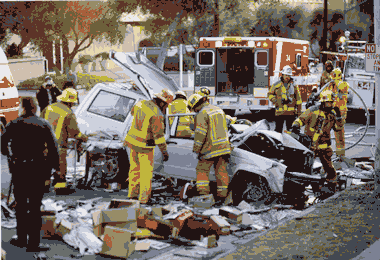
Source: Digital Stock, a division of Corbis Corporation.
Large-scale incidents are by definition more complex and may require coordination and resource assistance from outside agencies, especially if the incident spans multiple jurisdictions or agencies. A hurricane, for example, would affect most agencies and jurisdictions located in the impact area. The impact and scope of large incidents requires special planning to ensure incidents which extend beyond a single agency or jurisdiction can be effectively managed and resolved.
A large-scale incident may require the TMC to play a support role for a broader emergency where it is only one of many responding agencies. TMCs are part of ESF 1: Transportation, which means they provide transportation resources and services in response to an emergency. TMCs may need to interact and coordinate extensively with outside agencies and jurisdictions, perhaps even some located out-of-state. In addition, the impacts of a larger incident may affect the communications or transportation infrastructure in ways that inhibit the response. That is why it is important for a TMC to plan for its role in supporting a large-scale emergency in the context of ESF 1.
Following are some examples of best practice emergency operations activities performed by the TMC during the initial and sustained response to a large-scale emergency:
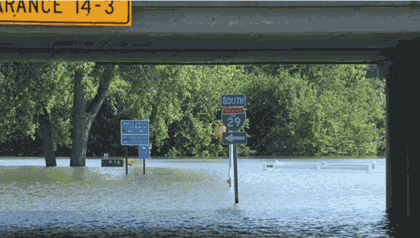
Photo courtesy of the Iowa DOT.
Historic flooding along the Missouri river’s 384.6-mile course along eastern Nebraska and parts of South Dakota, Iowa, and Missouri washed out hundreds of thousands of acres of farmland, swamping rural homes, overflowing highways, and threatening cities, railroads, power plants, and airports. Since the flooding event did have some advance warning, the Iowa DOT began preparations long before the water topped the banks of the Missouri River from Sioux City south into Missouri. In early June, the Iowa DOT began preparing for what has become the worst Missouri River flooding in recorded history. Equipment and supplies were moved to higher ground, and the Onawa rest areas were closed to serve as a materials storage area for flood mitigation efforts along I-29 near Blencoe and U.S. 30 near Missouri Valley. DOT emergency managers held daily strategy sessions to set the course for the long flood event. The statewide TMC disseminated information via 511, web site, and message boards, and coordinated with other local and state agencies since the road was closed for many months.
Following are best practice emergency operations typically performed by the TMC after the event and the recovery phase has commenced.
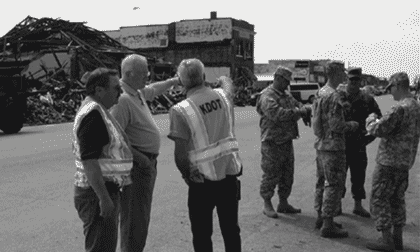
Photo courtesy of the Kansas DOT.
An F-5 tornado ripped through the town of Greensburg and in minutes left an unimaginable path of destruction. The long road to recovery started immediately and from the beginning, the Kansas Department of Transportation (KDOT) was there to provide a helping hand. KDOT’s efforts included search and rescue, debris removal and cleaning of roadways, and clearing property easements for restoration of utilities. KDOT deployed mobile Communications on Wheels to assist law enforcement and the National Guard. KDOT assisted with traffic control through barricades and the TMC provided message boards operations and 511 updates.
Following are best practice emergency operations activities typically performed by the TMC after the recovery phase has been concluded and the restoration phase is underway.
During large-scale events, the TMC should integrate with the State EOC, which has the ability to communicate directly with local emergency management offices, state police troops or districts, and Federal agencies. Some states also have regional EOCs that coordinate disaster/emergency response with multiple communities in a geographic region. The TMC can integrate with the State EOC by sending a liaison, which aids communication, coordination, and resource request and fulfillment between the agencies. In addition, TMCs often have access to valuable camera and sensor networks that provide the State EOC and decision-makers with real-time information from the incident scene.
Large-scale emergencies may have a long recovery phase which overlaps into the postevent phase. Activities may include reestablishing the TMC and supporting infrastructure. For large emergencies, certain hazards may also require specific additional considerations. These hazards include the following:
Terrorist Events – Public safety and transportation agencies recognize the importance of managing surface transportation during and after a terrorist incident. The same types of homeland defense information exchanged between transportation and public safety agencies can be applied to the less serious (but more common) incidents of crime and traffic law enforcement. Regular use of information between transportation and public service agencies will heighten awareness of the information’s value and increase the skills for using the information. Such an improvement will serve the public well should another terrorist event occur. To prepare for a this type of event, TMCs should do the following:
The TMC can use the following checklist to evaluate their current status in regard to emergency operations activities typically performed by the TMC during the initial and sustained response, during and after the recovery phase of a large-scale emergency (check all that apply):
Initial Response
❑ Mobilizes TMC representative to the appropriate state or agency EOC or Unified Command Center (UCC) as requested.
❑ Configures communications to maximize interoperability with other agencies.
❑ Focuses information gathering resources on the incident area (cameras, traffic monitoring services, personnel on-scene) and relays information as needed.
❑ Responds in a prioritized manner in accordance with decisions made internally or externally from the EOC or UCC.
❑ Fulfills resource requests as possible, while filtering requests to ensure the request is appropriate in both timing and purpose.
❑ Provides public information in the form of dynamic message signs (DMS), 511 updates, and TMC social media.
Initial Recovery
❑ Continues focusing information gathering resources on the incident area (cameras, traffic monitoring services, personnel on-scene) and relays information as needed.
❑ Continues fulfilling resource requests as possible, while filtering requests to ensure the request is appropriate in both timing (avoiding requests for future needs) and purpose (avoiding mission/equipment mismatches).
❑ Provides guidance and resources to local communities and agencies as appropriate on recovery activities, including debris management.
❑ Continues providing public information in the form of DMS and sharing of appropriate information with the media.
After Recovery
❑ Returns communications to pre-event configuration.
❑ Returns information gathering resources to pre-event configuration (cameras, traffic monitoring services, personnel).
❑ Demobilizes TMC liaison to external EOC or UCC.
❑ Retains all incident documentation and begins After Event Action Review process.
❑ Integrates with the State EOC by sending a liaison, and provides real-time information from the incident scene.
❑ Develops a plan for large-scale emergencies that (check all that apply):
❑ Offers traffic monitoring and management capabilities, and communication and coordination functions (camera networks and access control systems) for use in handling large volumes of self-evacuees.
❑ Maintains contacts and relationships with agencies equipped to handle specialized incidents, including those that are chemical, biological, and radiological.
❑ Helps to secure the affected area and activate appropriate alternate routes when the affected area will be inaccessible and unusable.
This section describes TMC supporting activities immediately prior to, during, and after large planned special events such as National Special Security Events (NSSE).
In 1998, President Clinton issued Presidential Decision Directive 62 (PDD-62) for the purpose of formalizing and delineating the roles and responsibilities of Federal agencies in the development of security plans for major events. This Presidential Directive focused on the role of each agency and eliminated the duplication of effort and resources. The Presidential Protection Act of 2000 became public law and included in the bill, was an amendment to Title 18, USC §3056, which codified PDD-62. With the support of Federal law, the Secret Service is authorized to participate “in the planning, coordination and implementation of security operations at special events of national significance.”
The Department of Homeland Security is the lead agency for the design and implementation of an operational security plan when the Secretary of the agency designates it as a NSSE. The Secret Service has developed a core strategy to carry out its security operations, which relies heavily on its established partnerships with law enforcement and public safety officials at the local, state, and Federal levels. The goal is to provide a safe and secure environment for the individuals the Secret Service is protecting, other dignitaries, the event participants, and the public. There is a tremendous amount of advance planning and coordination prior to the event, particularly at the venue and along the motorcade route, in communications, credentialing, and training. An example of an NSSE was the 2008 Democratic National Convention in Denver, Colorado in August 2008. The acceptance speech by nominee Barack Obama at INVESCO field before a record-setting crowd of 84,000 people was designated an NSSE.
While these preplanned and large-scale special events are not emergencies, some of the resources and actions could apply to an emergency. Specific coordination activities between the TMC and emergency operations may include monitoring and traffic control prior to the event, and monitoring of routes during the event in case of emergency or in preparation for the end of the event. TMCs also can provide support to management of exiting traffic.
During the pre-event phase, the key components of a traffic management plan include plans for site access and parking, pedestrian access, traffic flow, traffic control, en-route traveler information, traffic surveillance, traffic incident management, and safety. A planned special event increases or disrupts the normal flow of traffic and places a premium on the optimal use of existing facilities. A traffic incident and safety plan specifies crash prevention tactics and traffic incident quick clearance initiatives, some for enactment on the day of the event. During this phase, TMCs can conduct the following activities:

Source: Comstock Images.
If the planned event warrants preparation of a formal traffic management plan, it will define how the TMC conducts certain functions and roles. These may be primary roles (surveillance, detection, message sign operation, ramp meter control), support roles (public relations campaign, tow truck staging), or coordinating roles (signal systems operation, service patrols).
The TMC may also conduct crash prevention tactics that focus on improving driver awareness of surroundings and driver behavior during planned special events, including portable lighting, congestion warning signs, public information safety campaigns, and enforcement.
On the day of the planned event, team organization includes agency representatives stationed at a central command post, at secondary command posts, at a permanent TMC, and at strategic locations in the field for traffic control and observation. The traffic management team generally functions under the ICS to ensure successful deployment of the traffic management plan and minimal impact to transportation system users. Unified command functions coordinate interjurisdictional and multidisciplinary stakeholders among the traffic management team so there is no sacrifice of agency authority, responsibility, or accountability. An advantage of using the ICS during a planned special event is that it clarifies how decisions are made if the traffic management plan requires adjustment.
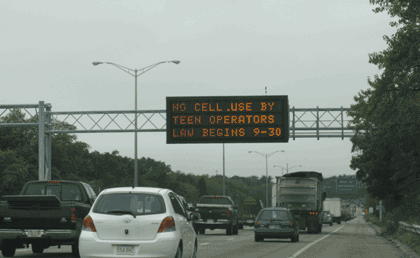
Source: Cambridge Systematics, Inc.
A number of factors affect traffic conditions either shortly before, or during the event. For events such as the Super Bowl and the NCAA Final Four, for instance, the participating teams are not known until shortly before the event (two weeks for the Super Bowl, one for the Final Four). Depending on the proximity of the participants, the mix of people driving or flying into the host city can vary greatly, with significant impacts on local traffic. Attendance at major festivals can also vary and a sudden outbreak of bad weather during an outdoor event can change the anticipated timing and patterns of traffic. As a result, plans need to be adjusted in the period immediately prior to the event or in some cases during the event. As an organization with the ability to monitor conditions over a wide area, the TMC may take on a greater role to address immediate changes. For the TMC, specific day-of-event activities involve the following:
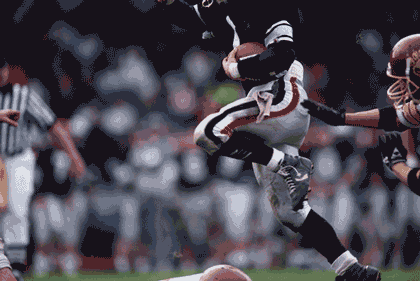
Source: Digital Stock, a division of Corbis Corporation.
The postevent phase for preplanned and large-scale special events is similar to other major events. Key events to conduct after special events with TMC participation include the following:
The TMC can use the following checklist to evaluate their current status in regard to participation in large planned events (check all that apply):
Pre-Event Phase
❑ Conducts Freeway Traffic Control through ramp closures, elimination of weaving areas, identification of alternate routes, and ramp metering adjustments.
❑ Maintains street traffic control through lane control, alternative lane operations, trailblazer signing, and parking management.
❑ Maintains intersection traffic control by access restriction, advance signing, and traffic signal timing and coordination.
❑ Conducts traffic incident management through service patrols, two truck staging, quick clearance, and advance warning signs.
❑ Conducts traffic surveillance through CCTV, media reports, and temporary ITS detection and surveillance.
❑ Provides en-route traveler information via DMS, Highway Advisory Radio, 511 systems, media, and smart phone apps/in-vehicle decisions.
❑ Provides pretrip traveler information through the Internet, 511 systems, pre-event public relations campaign, media, and roadside traveler information systems.
❑ Conducts crash prevention tactics, including portable lighting, congestion warning signs, public information safety campaign, and enforcement.
Response and Recovery Phases
❑ Coordinates with field personnel to make sure temporary traffic modifications are in place, i.e., DMS and other traveler information services.
❑ Monitors traffic conditions; provide traveler information services; coordinate with DOT maintenance and field crews to provide additional resources where needed.
❑ Coordinates with local agencies that control signals and local streets, ramp meter operation.
❑ Supports quick clearance and incident management activities.
Postevent Phase
❑ Participates in a debriefing with all stakeholders to review the original plan and compare it to the actual events to see what aspects of the plan worked and which need improvement.
❑ Assists with the transportation section of a postevent report documenting the event and making recommendations for improvements in the process.
❑ Documents any exceptional costs incurred in transportation activities.
❑ Archives data and event documentation for use in future planning efforts.
You may need the Adobe® Reader® to view the PDFs on this page.
|
United States Department of Transportation - Federal Highway Administration |
||